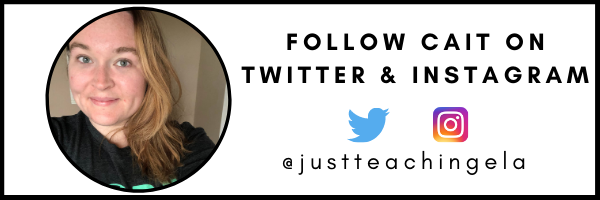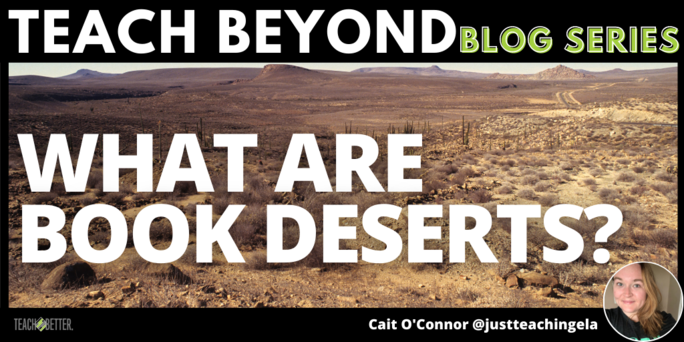TL;DR:
- A book desert is defined as a “geographic area with limited access to age-appropriate books, print materials and reading culture.”
- Reading requires time and access to materials. Students have a right to quality, diverse, and robust selections of books.
- Consider representation in reading materials. Readers who can see themselves in books are more likely to pick up more books.
What is a Book Desert?
A book desert is defined as a “geographic area with limited access to age-appropriate books, print materials and reading culture.”
Many Americans are familiar with a more studied term, food deserts. In food deserts, access to nutritious food is limited due to climate, economy, and socioeconomic status.
Book deserts are similar. Income and reading access overlap in similar ways with food and other resources like housing, parks, library funding, and more, especially in low-income communities across America (Neuman and Moland, 2019).
Even in library-forward communities, however, book deserts may reflect places where books are not frequently accessed, read, or owned in homes. For many, reading and the time it takes to engage with stories (including movies) is a luxury. This is especially true of print stories; it requires a different set of cognitive skills that may differ from those required to consume other media.
The Impact of Limited Reading Materials
According to Neuman & Celano, authors of Giving Children a Fighting Chance: Poverty, Literacy and the Development of Information Capital (2012), book deserts impact student learning readiness for several reasons.
Access to a library does not guarantee that children will be exposed to reading behaviors. Celano & Neuman found that the rise in libraries as media centers adapting to the 21st century left libraries in a state that resembled a video arcade, as opposed to a reading-centered space.
“Studies have shown that access to print resources—board books, stories, and informational books—early on in a child’s development has both an immediate and long-term effect on their vocabulary, background knowledge, and comprehension skills” (Allington et al., 2010). Lack of establishment of an early readerly life may affect comprehension, attention, and other things students need in order to learn effectively. This has lasting impacts on students in their secondary years and even into adulthood.
Secondary Level Impact
Jean Twenge states that “In 1980, 60% of 12th graders said they read a book, newspaper or magazine every day that wasn’t assigned for school. By 2016, only 16% did – a huge drop, even though the book, newspaper or magazine could be one read on a digital device (the survey question doesn’t specify format).” (Twenge, 2018). She said, “The number of 12th graders who said they had not read any books for pleasure in the last year nearly tripled, landing at one out of three by 2016.”
Another point to consider is that it is in humans’ nature to find and take shortcuts. If reading a shorter text is going to mean less work, students are more inclined to read fewer pages as opposed to a more challenging work. This is something I have noticed firsthand with my own students. However, this inclination to “work smart, not hard” could be impacting young people’s desire to read and their ability to more resiliently consume long-form texts. In order to keep students interested in reading beyond elementary and middle school, they need to have access to high-interest, challenging reading.
Kids Need More Books
Due to the rise of sites like Amazon and rising retail rents across America, bookstores are on the decline. Some communities/entire regions in America no longer have bookstores. In 2016, the Bronx was left with zero general interest bookstores until the opening of the Lit. Bar in 2019 in the Mott Haven area and Bronx Bound Books, a bookmobile that travels through the borough to deliver and sell books to BX residents.
Recycling print materials and making them more affordable for communities with a vulnerable reading culture could help to reduce the impact of book deserts. Click To TweetAnother barrier to at-home reading culture and book ownership is the retail pricing of books. EndBookDeserts found that 45 percent of children live in areas lacking access to print books. They also found that 67 percent of our nation’s lowest-income schools cannot afford books at retail price.
This makes libraries and websites like ThriftBooks more appealing, and the ever-expanding access to books through apps and digital library card access could potentially alleviate this issue. Recycling print materials and making them more affordable for communities with a vulnerable reading culture could help to reduce the impact of book deserts.
Limitations of the Current Data
Unite For Literacy’s maps show projections of book deserts across America. Some areas indicate that as few as three percent of households have 100 or fewer books in the home. The projection of attachment to household income limits the current data. The towns reflected in these maps are not specifically and concretely outlined as book deserts, but as low-income communities with reading access issues correlated to poverty.
I look forward to doing research that seeks to validate this data based on discussions about books and reading in my own community. I am also interested in how we approach book deserts from more of a perspective of mutual aid, solidarity, and liberation, as opposed to charity, as many current models addressing this issue are predicated on.
So how do we get students not only to access books but actually enjoy reading them?
Modeling Reading Behaviors
According to the 2020 World Literacy Report, 28 percent of adults had not read a book between the years 2019-2020. In order to increase students’ reading and willingness not only to start reading but to continue developing reading identities and readerly lives, the adults around them must model sustained reading practices.
Reading also requires set-aside time—time that families working long hours or multiple jobs do not always have. This makes audiobooks more ideal, as readers can listen to books in the car, on transportation, on their way home, and before sleep.
Most libraries are expanding their access to non-print materials using applications like Overdrive and SORA. Access to these materials also depends on readers’ access to a stable WiFi connection. Using these tools, patrons can apply their library card and check out books from a mobile device. Reading is becoming easier and more accessible, and I wonder about the gaps that continue to persist despite the growing digital nature of reading.
I want to be clear that in understanding book deserts, I emphasize resource allocation blame rather than caretaker blame. We know that access to reading is important for early childhood development, but when resources are already scarce in a community due to things like redlining, Internet access, municipal financial mismanagement, and income segregation, this leads caretakers (and kids) to prioritize their basic physiological needs first. Food and shelter are directly linked to employment and a paycheck. In these instances where poverty is at the forefront, books remain a luxury and so does the free time to read them.
When resources are already scarce in a community due to things like redlining, Internet access, municipal financial mismanagement, and income segregation, this leads caretakers (and kids) to prioritize their basic physiological… Click To TweetReading Opportunities Are Everywhere
We all laugh about the kids who sat at the table eating breakfast and reading the labels on the cereal box (I was that kid), but we have to start somewhere. Reading labels and directions on products we use every day or reading signs while driving in the car are all valuable literacy practices for children from any income background to adopt. They foster not only vocabulary and letter recognition, but curiosity.
One of my earliest memories of reading recognition actually came from a movie. I was about three or four years old, and my grandparents lived in an industrialized area of our town. We often drove by a factory for a company called Hercules. One day I blurted out, “They must make really strong things!”
My recognition of the letters on the factory, matched with my understanding of the Disney movie—whose VHS tape I’d practically worn out by preschool—was a literacy practice that stunned even my grandparents who exposed me to books from an early age (my grandmother was a teacher’s assistant, which only inevitably destined me for teaching).
Expanding the Meaning of “Right to Read”
Students have a right to quality, diverse, and robust selections of books. Communities of all types can engage in the effort to bring more books to more households. Readers have the right to read books in languages other than English and share those experiences with family or peers who share their common language.
Encouraging students to read means they first need access to print materials, and that they should see people engaging with reading materials, too. Regardless of the format, modeling the intake of information is important for young readers to see, hear, and experience. Knowledge is our human birthright.
Twenge asserts in her article that “Reading books and longer articles is one of the best ways to learn how to think critically, understand complex issues and separate fact from fiction. It’s crucial for being an informed voter, an involved citizen, a successful college student and a productive employee.”
What if we started where students are and expanded their definition of what a text is or what reading entails? It is certainly possible to analyze films and Instagram posts as fervently as a novel; I’ve done it in my own classroom.
Last year, students analyzed Black Panther and the hero’s journey as an alternative to Homer’s The Odyssey. To apply those same cognitive skills students use when extracting meaning from books, I treated the film like a novel. We pointed out and “close read” characterization, conflict, and other elements they’d traditionally discuss and write about while reading books.
[scroll down to keep reading]
We Need More Diverse Books
Another consideration is representation. Readers who can see themselves in books are more likely to pick up more books and “read into” different experiences. The work of Dr. Rudine Sims Bishop of presenting reading as “windows, mirrors and sliding doors” is fundamental. It helps us understand what gets kids reading and what keeps them reading for life. Initiatives like ProjectLitComm and We Need Diverse Books advocates for both literacy and representation in books, especially representation of historically excluded voices, people, and groups.
Students have the right to read. Whatever genre and format gets them to read and stay reading is worth celebrating. There is no such thing as “not a real book.” Graphic novels count. Magazines and video game cheat guides count. I’ve learned some of the most important and interesting facts from graphic novels like Guantanamo Voices and Ellen Forney’s Rock Steady. If students can hold it, hear it, read it, and make sense of it, let them. Reading is reading is reading. Policing what they read and how they read only widens the gap.
Follow on Twitter!
@BklynBookBodega @LatinxKidLitBF @FreadomUSA @DiverseBooks
Resources
https://www.endbookdeserts.com/
About Unite for Literacy. Unite for Literacy. Retrieved July 27, 2021, from https://www.uniteforliteracy.com/corp/about
Allington, R., McGill-Franzen, A., Camilli, G., Williams, L., Graff, J., Zeig, J., & Nowak, R. (2010). Addressing summer setback among economically disadvantaged elementary students. Reading Psychology, 31, 411-427.
Neuman, S. B., & Celano, D. (2012). Giving our children a fighting chance : poverty, literacy, and the development of information capital. Teachers College Press.
Neuman, S. B., & Moland, N. (2016). Book Deserts: The Consequences of Income Segregation on Children’s Access to Print. Urban Education, 54(1), 126–147. https://doi.org/10.1177/0042085916654525
Twenge, J. (2018). Why it Matters that Teens are Reading Less. CommonLit.
Unite for Literacy. Retrieved July 27, 2021, from https://www.uniteforliteracy.com/corp/esri
About Cait O’Connor
Cait O’Connor is a fourth-year public school English/ESOL educator in New York, committed to social justice and equity in education and beyond.



